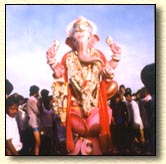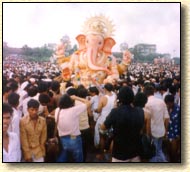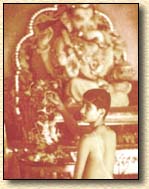 |
 |
|
 |
 |
GANESH CHATURTHI
Ganesha, the elephant-headed son of Shiva and Parvati is widely worshipped as the munificent god of wisdom. Ganesh Chaturthi is a festival in his honour and is celebrated in the states of Maharashtra, Tamil Nadu, Karnataka and Andhra Pradesh. To appreciate this occasion, one must go to Mumbai where preparations begin months in advance. Images of Ganesha are installed within homes as well as in places of assembly. Elaborate arrangements are made for lighting and decoration and Ganesha is fervently worshipped for about 7-10 days. On the day of the Chaturthi, i.e. the last of the days dedicated to the elephant-headed god, thousands of processions converge on the beaches of Mumbai to immerse the holy idols in the sea. This immersion is accompanied by drum beats, devotional songs and dancing.
Dates : It is celebrated as the birth anniversary of Ganesha, the god of wisdom and prosperity on the fourth day of Bhadra (August/September).
 Legend/s
: Ganesha
is the god of wisdom and prosperity and is invoked before the beginning of
any auspicious work by the Hindus. According to mythology he is the son of
Shiva and Parvati, brother of Kartikeya - the general of the gods, Lakshmi
- the goddess of wealth and Saraswati-the goddess of learning. This
elephant-headed god, whose vehicle is the Mooshak or rat and who
loves Modaks (round sweets) is associated with several humourous
tales and lores. Tales of how he beat his brother Kartikeya, in a race
which involved going around the world thrice, without even moving out of
his house, of how he lost one of his tusks are known to children all over
India.
Legend/s
: Ganesha
is the god of wisdom and prosperity and is invoked before the beginning of
any auspicious work by the Hindus. According to mythology he is the son of
Shiva and Parvati, brother of Kartikeya - the general of the gods, Lakshmi
- the goddess of wealth and Saraswati-the goddess of learning. This
elephant-headed god, whose vehicle is the Mooshak or rat and who
loves Modaks (round sweets) is associated with several humourous
tales and lores. Tales of how he beat his brother Kartikeya, in a race
which involved going around the world thrice, without even moving out of
his house, of how he lost one of his tusks are known to children all over
India.
Legend has it that Parvati created Ganesha out of the sandalwood dough that she used for her bath and breathed life into him. Letting him stand guard at the door she went to have her bath. When her husband, Shiva returned, the child who had never seen him stopped him. Shiva severed the head of the child and entered his house. Parvati, learning that her son was dead, was distraught and asked Shiva to revive him. Shiva cut off the head of an elephant and fixed it on the body of Ganesha.
 There
are numerous stories associated with the birth of Ganesha and all are told
during the time of the festival. Another story says that the Gods decided
to choose their leader and a race was to be held between the brothers'
Kartikeya and Ganesh. Whoever took three rounds of the earth first would
be made the Ganaadhipati or the leader. Kartikeya seated on a peacock, his
vahanam (vehicle), started off for the test. Vinayak or Ganesh
was given a rat, which moves swiftly. Vinayak realised that the test was
not easy, but he could not disobey his father. He reverently paid
obeisance to his parents and went around them three times and completed
the test before Kumarswami (Kartikeya). According to him, " my
parents pervade the whole universe and going around them, is more than
going round the earth." Everybody was pleasantly surprised to hear
Vinayak's logic and intelligence. Meanwhile, Kartik was amazed to see
Ganesh completing the holy bath at each river that he reached at and ready
for another round of the universe.
There
are numerous stories associated with the birth of Ganesha and all are told
during the time of the festival. Another story says that the Gods decided
to choose their leader and a race was to be held between the brothers'
Kartikeya and Ganesh. Whoever took three rounds of the earth first would
be made the Ganaadhipati or the leader. Kartikeya seated on a peacock, his
vahanam (vehicle), started off for the test. Vinayak or Ganesh
was given a rat, which moves swiftly. Vinayak realised that the test was
not easy, but he could not disobey his father. He reverently paid
obeisance to his parents and went around them three times and completed
the test before Kumarswami (Kartikeya). According to him, " my
parents pervade the whole universe and going around them, is more than
going round the earth." Everybody was pleasantly surprised to hear
Vinayak's logic and intelligence. Meanwhile, Kartik was amazed to see
Ganesh completing the holy bath at each river that he reached at and ready
for another round of the universe.
Practice : Ganesha is the munificent god of wisdom and Ganesh Chaturthi is celebrated in his honour and in the states of Maharashtra, Tamil Nadu, Karnataka and Andhra Pradesh and many other parts of India. In Bombay alone, more than 6000 Ganesha statues are commissioned collectively by factories. Upto 10 metres in height these statues are carried on decorated floats. Little Ganeshas are placed in nukkads or street corners and in homes, and poojas are performed daily.
 Started
by Shivaji, the great Maratha ruler, to promote culture and nationalism,
the festival was revived by Lokmanya Bal Gangadhar Tilak to spread the
message of freedom struggle and to defy the British who had banned public
assemblies. The festival gave the Indians a feeling of unity and revived
their patriotic spirit and faith. This public festival formed the
background for political leaders who delivered speeches to inspire people
against the Western rule. The festival is so popular that in Mumbai the
preparations begin months in advance. Images of Ganesha are installed and
elaborate arrangements are made for lighting and decoration, and
celebrations are on for 7-10 days. The Chaturthi is the last day dedicated
to the elephant-headed god, and thousands of processions converge on the
beaches of Mumbai to immerse the holy idols in the sea. This immersion is
accompanied by drum- beats, devotional songs and dancing. It is also
forbidden to look at the moon on that day as the moon had laughed at
Ganesha when he fell from his vehicle, the rat.
Started
by Shivaji, the great Maratha ruler, to promote culture and nationalism,
the festival was revived by Lokmanya Bal Gangadhar Tilak to spread the
message of freedom struggle and to defy the British who had banned public
assemblies. The festival gave the Indians a feeling of unity and revived
their patriotic spirit and faith. This public festival formed the
background for political leaders who delivered speeches to inspire people
against the Western rule. The festival is so popular that in Mumbai the
preparations begin months in advance. Images of Ganesha are installed and
elaborate arrangements are made for lighting and decoration, and
celebrations are on for 7-10 days. The Chaturthi is the last day dedicated
to the elephant-headed god, and thousands of processions converge on the
beaches of Mumbai to immerse the holy idols in the sea. This immersion is
accompanied by drum- beats, devotional songs and dancing. It is also
forbidden to look at the moon on that day as the moon had laughed at
Ganesha when he fell from his vehicle, the rat.
In Hyderabad, the artists who make the idols of Ganesh compete with each other to make bigger and more magnificent and elegant idols. Every year, the largest Ganesh idol is installed at Khairatabad in Hyderabad, which is more than 30 ft tall. On the 11th day, on Ananta Chaturdashi, processions of Ganesh, amidst roaring music converge at the Hussain Sagar - the lake that connects Hyderabad and Secunderabad. Idols are decorated with flowers, pearls and coins. A few of them are also made up of dryfruits like almonds, cashew nuts and raisins. Devotees wearing saffron caps accompany the idols and sprinkle gulal (a pink powder), while dancing to the tune of drums. With the immersion of the idol amidst the chanting of "Ganesh Maharaj Ki Jai!" and "Ganpati bappa morya" the festival ends with pleas to Ganesha to return the next year.
In Sanskrit language, there are more than one meaning attached to a word. For example, the word GO means cow as well as sense organs. Gopal means cowherd. Gopal also means a yogi whose sense organs are completely under his control. This dual meaning enables poets to bring out their best on the physical plane as well as on the spiritual plane.
We have Krishna the cowherd boy in Vraj and Vrindavan, and we have Gopalnanda Krishna, the yogeshwar, milking the Upanishads, and the milk is the great nectar of the Bhagavad Gita.(Gita Dhyanam, verse 4, usually found at the beginning of Bhagavad Gita books). The maakhan (cream) or the gist or essence of the Upanishads is presented in the Bhagavad Gita. This is what the `makkhan chor' took from the Upanishads and distributed for the benefit of mankind.
Similarly, a common Sanskrit word to denote elephant is GAJA. Here Gajanan means elephant faced - a name for Ganapati. But the word Gaja has a much deeper connotation. GA indicates gati, the final goal towards which the entire creation is moving, whether knowingly or unknowingly. JA stands for janma, birth or origin. Hence GAJA signifies GOD from whom worlds have come out and towards whom they are progressing, to be ultimately dissolved in Him. The elephant head is thus purely symbolical.
We observe creation in its two fold manifestation as the microcosm (sukshmanda) and the macrocosm (brahmanda). Each is a replica of the other. They are one in two and two in one. The elephant head stands for the macrocosm (representing vastness or bigness), and the human body for the microcosm. The two form one unit. Since the macrocosm is the goal of the microcosm, the elephant part has been given greater prominence by making it a head.
The Chandogya Upanishad has pronounced a philisophical truth as TAT-TVAM-ASI, THAT- THOU -ART. It simply means "You, the apparently limited individual, are in essence, the cosmic Truth, the Absolute". The elephant-human form of Ganapati is the iconographical representation of this great Vedantic dictum. the elephant stands for the cosmic whereas the human stands for the individual. The single image reflects their identity.
Vedanta is the synthesis of the `within' and the `without'; the macrocosm and the microcosm. The study of this `within' of nature through an inquiry into the `within' of man, who is the unique product of nature`s evolution, is religion according to Indian thought. The synthesis of the knowledge of the `without' , which the physical sciences give, and the `within' which religion gives, is what India achieved in her Vedanta. This she calls BRAHMA - VIDYA or philosophy; God or Brahman(`BRAHMAN' is the Upanishdic term for the Supreme Reality, God) standing for the totality of reality, physical and non-physical. Brahma - vidya is Sarva - vidya- pratishtha (philosophy is the basis and support of all knowledge) says the Mundaka Upanishad (i.i.i.).
The Ganapati Upanishad identifies Lord Ganesh with the Supreme Self. Lord Ganesh represents the Pranava (AUM) which is the symbol of the Supreme Self. Taitiriya Upanishad (1.8.1.) states: "AUM ITI BRAHMAN -AUM is Brahman (GOD). AUM is all this . Nothing can be done without uttering it. This explains the practice of invokong Lord Ganesh before beginning any rite or undertaking any project.
Lord Ganesh removes all obstacles on the path of the spiritual aspirant, and bestows upon him worldly as well as spiritual success. So he is called VIGNA VINAYAKA or VIGHNESHWAR.